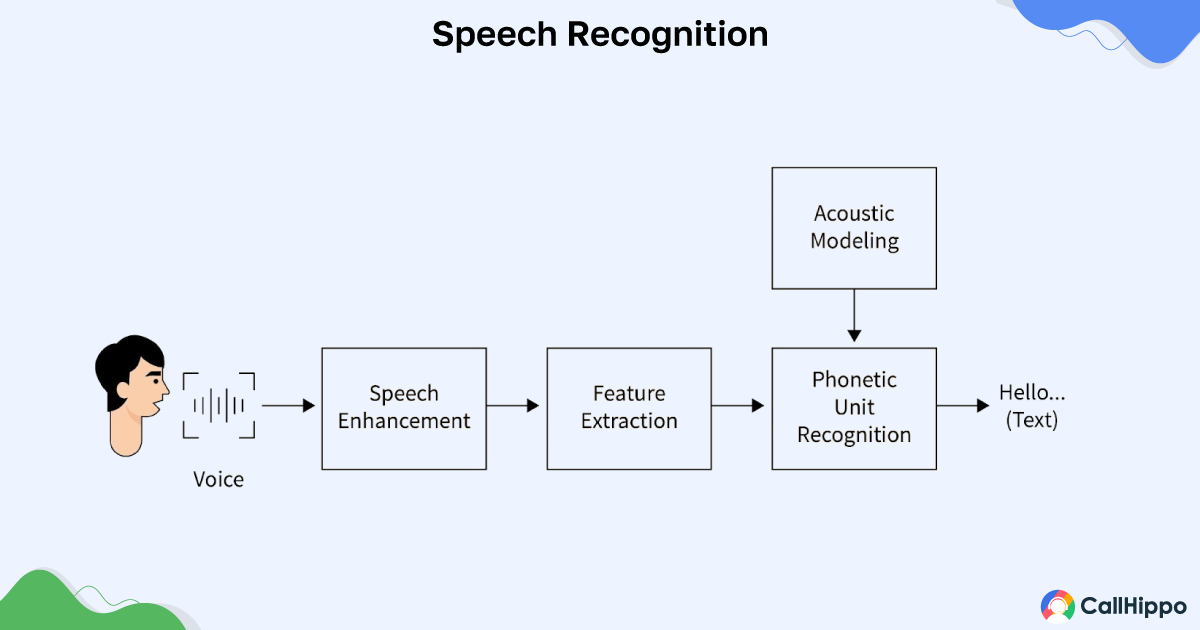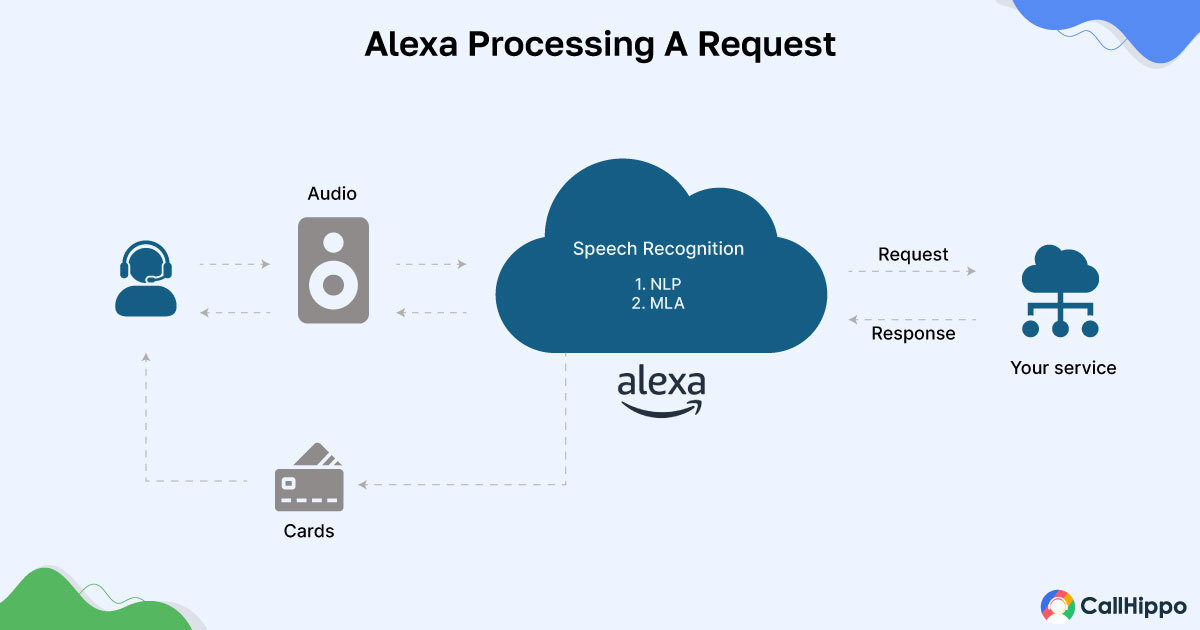Unlocking The Power of Speech Recognition in AI in 10 seconds !
Speech recognition in AI is a technology that enables machines to understand, interpret, and convert spoken language into text or executable commands. It forms the foundation of voice-enabled tools like virtual assistants, automated customer service, and real-time transcription systems.
How It Works:
- Uses neural networks to process complex speech patterns similar to how the human brain functions.
- Applies natural language processing (NLP) to understand context, meaning, and user intent.
- Relies on acoustic modeling to identify sound patterns and convert speech to text.
- Trained on large speech datasets featuring diverse accents, languages, and environments.
- Continuously improves through machine learning and user feedback for higher accuracy.
- Handles real-time noise filtering and multilingual support for improved recognition.
Key Applications
- Consumer Electronics: Voice assistants like Siri and Alexa for hands-free device control.
- Healthcare: Medical dictation, EHR updates, and improved doctor-patient communication.
- Automotive: In-car voice commands for infotainment, navigation, and climate control.
- Customer Service & Call Centers: AI voice bots and transcription for smart support.
- Banking: Secure voice authentication for transactions and user access.
- Telecommunications: AI-powered troubleshooting and virtual agents for user support.
- Media & Marketing: Voice search, ad targeting, and personalized content delivery.
- Sales: Automated call logging and speech-based prospect analysis.
- Security: Voice biometrics for fraud prevention and identity verification.
AI-powered speech recognition is improving how we interact with technology, shaping everything from smartphones to healthcare and customer service tools. The global speech and voice recognition market is projected to grow from USD 15.46 billion in 2024 to USD 81.59 billion by 2032.
This rapid adoption is driven by advances in NLP and machine learning, enabling more natural, intuitive voice interactions. Let’s explore how speech recognition in AI is empowering smarter, faster, and more intuitive voice technology.
What is Speech Recognition in AI?
Speech recognition in AI is a technology that allows machines to listen to spoken language, interpret its meaning, and convert it into written text or actionable commands. It plays a critical role in powering voice-enabled applications such as virtual assistants (like Siri, Alexa, and Google Assistant), automated customer support systems, smart devices, and real-time transcription tools.

This technology is built on a foundation of advanced machine learning algorithms, natural language processing (NLP), and acoustic modelling. Together, these components help AI systems analyse speech patterns, recognize various accents and dialects, filter out background noise, and understand the intent behind spoken words. As this technology advances, it is transforming how we interact with digital systems.
How AI Voice Recognition Works?
AI voice recognition relies on advanced models like neural networks, natural language processing (NLP), and acoustic modeling. Neural networks help process complex speech patterns by mimicking how the human brain works. NLP enables systems to understand context, intent, and meaning in spoken language. This lets AI have multi-turn conversations, where it remembers what you said earlier and responds more naturally.
Voice recognition systems are trained on massive datasets containing thousands of hours of recorded speech. These datasets include various languages, accents, and speaking conditions. Through continuous learning, AI models refine their accuracy over time, learning from user corrections, new speech inputs, and contextual usage.
Key Features for Speech Recognition in AI
Modern speech recognition in AI systems offers capabilities that make them smarter and more useful than ever.
1. AI and Machine Learning Integration
By integrating deep learning and machine learning algorithms, AI voice recognition becomes more adaptive. It can detect patterns, predict user intent, and improve outcomes with each interaction. The more it listens, the smarter it becomes. For example, Google’s machine learning-powered voice recognition technology can identify human speech with up to 95% accuracy.
2. Learn and Evolve Responses
Unlike traditional voice tools that require manual updates, modern systems can adapt very quickly. They self-optimize based on user behavior, language evolution, and domain-specific vocabulary, such as technical or legal terms.
3. Customization
Businesses can customize AI models to suit their industry or audience. Whether it’s a banking assistant or a healthcare bot, systems can be fine-tuned for better domain understanding, resulting in improved response quality and user satisfaction.
"Invest in AI speech recognition with context awareness, multilingual support, and real-time accuracy. Choose platforms that are secure, scalable, and easy to customize."
CallHippo: Empowering Smarter Conversations with AI-Powered Speech Recognition
At CallHippo, we harness the power of AI-driven speech recognition to transform the way businesses communicate. Our cutting-edge AI Voice Agent combines real-time speech-to-text technology with advanced natural language processing (NLP) to understand, interpret, and respond to customer queries with remarkable human-like precision.
From managing inbound calls and qualifying leads to providing multilingual support and auto-transcribing conversations, CallHippo delivers smart, context-aware voice interactions that enhance customer experiences and boost operational efficiency.
Speech Recognition AI Examples
Speech recognition in AI is revolutionizing how businesses operate across industries, from healthcare to retail. These real-world AI voice recognition examples highlight its practical impact and growing adoption.
1. Consumer Electronics

Voice assistants like Siri, Alexa, and Google Assistant use AI speech recognition and AI answering systems to perform tasks, answer queries, and control smart home devices. These advanced technologies are designed for hands-free convenience, delivering accurate responses and enhancing everyday digital interactions through seamless, intelligent support.
2. Healthcare
AI tools are used for medical dictation, patient interactions, and electronic health record updates—saving doctors time while improving accuracy. Speech recognition also helps reduce documentation errors and enhances patient communication.
3. Automotive Industry
Modern vehicles feature voice recognition AI to manage infotainment systems, navigation, and even climate control while driving. This ensures driver safety and convenience by minimizing manual distractions.
4. Customer Service
AI voice bots are replacing basic IVR systems, offering faster, more intelligent support through voice-driven navigation and solutions.
They can understand intent, route queries smartly, and improve overall customer satisfaction voice bots are replacing basic IVR systems, offering faster, more intelligent support through voice-driven navigation and solutions.
5. Call Centers
Call centers are leveraging AI for voice recognition to automate call routing, generate real-time transcripts, and perform post-call sentiment analysis. This boosts efficiency, improves call quality, and delivers actionable business insights.
6. Banking
Banks use voice recognition AI for secure authentication, allowing users to access accounts or authorize transactions with their voice. This adds a biometric security layer while making banking more user-friendly and efficient.
7. Telecommunications
Telcos are using voice-based troubleshooting systems and virtual agents powered by AI speech recognition to resolve user issues at scale. These intelligent systems understand natural language, guide users through problem-solving steps, and offer real-time solutions without the need for human intervention.
8. Media and Marketing
Streaming platforms and digital marketers use voice recognition in AI for voice-enabled search, ad targeting, and personalized content recommendations. This helps brands engage users more effectively based on spoken commands and behavior.
9. Sales
Sales teams rely on AI voice recognition technology to log call details, qualify prospects, and tailor conversations based on speech data. This makes outreach efforts more personalized and results-driven.
10. Security
Voice biometrics powered by AI are used for secure identity verification and fraud prevention in finance, telecom, and enterprise systems. This AI-powered voice recognition ensures secure access using each person’s unique vocal signature.
Key Challenges of AI Speech Recognition & How CallHippo Addresses Them
AI speech recognition has made impressive strides, but it still faces challenges like accent variability, background noise, and contextual understanding. These hurdles can impact accuracy and user experience. Here’s how CallHippo AI Voice Agent effectively tackles these issues with smart, adaptive solutions.
1. Accents & Language Coverage: Multilingual Model Handling
One of the biggest challenges is recognizing various accents and regional dialects. CallHippo tackles this with multilingual voice agents, trained across a diverse dataset, ensuring clarity and context no matter where the customer is calling from.
2. Background Noise & Accuracy: Real-Time Signal Processing
Ambient sounds can confuse systems. CallHippo leverages real-time audio filtering and signal enhancement, delivering clear recognition even in noisy environments like call centers or outdoor settings.
3. Privacy & CRM Integration: Secure Data Handling
Voice data is sensitive. CallHippo ensures GDPR-compliant, encrypted data storage and seamless CRM integrations for secure and personalized interactions.
4. Deployment & Scalability: No-Code Setup & White?Labeling
Scalability can be complex, but with no-code setup options, white-labelled voice agents, and easily customizable modules, CallHippo makes enterprise-level deployment simple and effective for all business sizes.
Per User/Month
- Automated Meeting Scheduling
- Transfer Call to Human Agent
- Multilingual Support
- Calendar Booking Assistant

Market and Future of Speech Recognition in AI
The market for speech recognition in AI is booming, and it’s only gaining momentum. While it has already transformed smartphones and call centers, the next frontier lies in wearables, smart home devices, AR/VR experiences, and metaverse communication.
In fact, 65% of people aged 25–49 use voice-enabled devices daily, and 61% expect their usage to increase, highlighting a growing shift in user behavior and expectations.
As advancements in natural language generation (NLG), speech synthesis, and voice cloning continue, future voice systems will go beyond understanding words. They’ll interpret tone, intent, and emotion, infusing conversations with empathy and emotional intelligence. This emotional intelligence is a key differentiator of conversational AI, allowing it to respond with context-aware empathy, making conversations feel more human and personalized.
Conclusion
From enabling smart speakers to redefining customer service, speech recognition in AI is unlocking the next era of voice-first interaction. With evolving algorithms, scalable platforms, and practical use cases across industries, voice technology is no longer a novelty — it’s a necessity.
Platforms like CallHippo are at the forefront, combining intelligent speech recognition with business automation to make every conversation smarter, faster, and more meaningful.
FAQs
What is speech recognition in AI?
It’s a technology that allows machines to understand and convert spoken language into text or actions, using AI and machine learning models.
How does AI recognize speech?
Through a combination of acoustic modelling, NLP, deep learning, and large datasets that help AI understand and interpret the structure, meaning, and intent behind human speech.
Which industries benefit most from AI speech recognition agents?
Industries like customer service, healthcare, banking, automotive, media, and telecom benefit greatly from voice-enabled AI solutions.
What type of AI is used in speech recognition?
Technologies include deep neural networks, natural language processing (NLP), acoustic models, and language modeling, often deployed through machine learning frameworks.

Subscribe to our newsletter & never miss our latest news and promotions.









